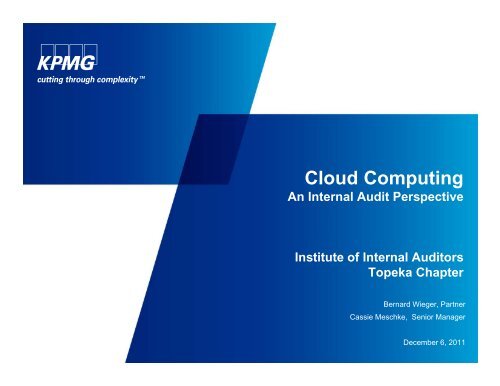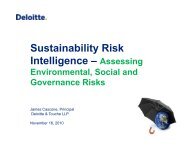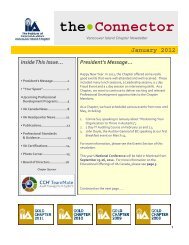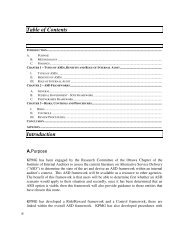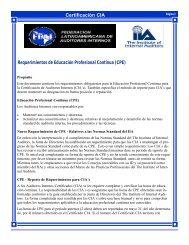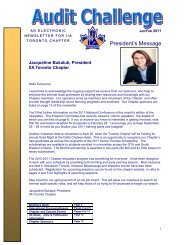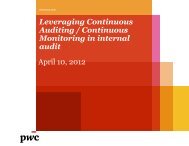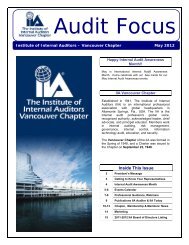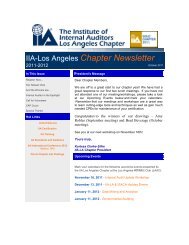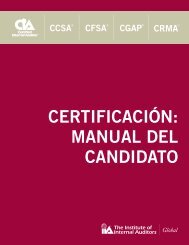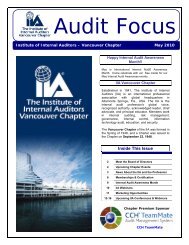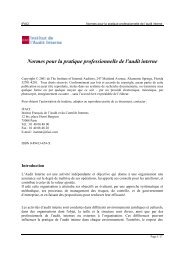KPMG - Cloud Computing An Internal Audit Perspective
KPMG - Cloud Computing An Internal Audit Perspective
KPMG - Cloud Computing An Internal Audit Perspective
You also want an ePaper? Increase the reach of your titles
YUMPU automatically turns print PDFs into web optimized ePapers that Google loves.
<strong>Cloud</strong> <strong>Computing</strong><br />
<strong>An</strong> <strong>Internal</strong> <strong>Audit</strong> <strong>Perspective</strong><br />
Institute of <strong>Internal</strong> <strong>Audit</strong>ors<br />
Topeka Chapter<br />
Bernard Wieger, Partner<br />
Cassie Meschke, Senior Manager<br />
December 6, 2011
Discussion Agenda<br />
• Introduction to cloud computing<br />
• Types of cloud services<br />
• Benefits, challenges, and risks<br />
• Questions for auditors<br />
• <strong>Audit</strong>ing the cloud arrangement – A case study<br />
• Emerging good practices<br />
• User auditor assurance – Various Third Party Assurances compared<br />
• References<br />
© 2011 <strong>KPMG</strong> LLP, a Delaware limited liability partnership and the U.S. member firm of the <strong>KPMG</strong> network of<br />
independent member firms affiliated with <strong>KPMG</strong> International Cooperative (“<strong>KPMG</strong> International”), a Swiss entity.<br />
All rights reserved. The <strong>KPMG</strong> name, logo and “cutting through complexity” are registered trademarks or trademarks of<br />
<strong>KPMG</strong> International.<br />
<strong>Cloud</strong> <strong>Computing</strong> – <strong>An</strong> <strong>Internal</strong> <strong>Audit</strong> <strong>Perspective</strong> 1
Tremendous Buzz Around <strong>Cloud</strong> <strong>Computing</strong><br />
“Spending on IT<br />
cloud services to<br />
grow almost<br />
threefold over the<br />
next five years”<br />
“Virtualization and <strong>Cloud</strong><br />
<strong>Computing</strong> are the top 2<br />
Technology priorities in<br />
2010”<br />
Gartner EXP Worldwide Survey of<br />
1600 CIOs<br />
“60% of virtualized<br />
servers will be less<br />
secure than the physical<br />
servers they replace<br />
through 2012”<br />
IDC Research (March 2009)<br />
“By 2012, 20 percent of<br />
businesses will own no IT<br />
assets”<br />
Gartner Press Release – March 2010<br />
Gartner’s top predictions for 2010 and<br />
beyond<br />
© 2011 <strong>KPMG</strong> LLP, a Delaware limited liability partnership and the U.S. member firm of the <strong>KPMG</strong> network of<br />
independent member firms affiliated with <strong>KPMG</strong> International Cooperative (“<strong>KPMG</strong> International”), a Swiss entity.<br />
All rights reserved. The <strong>KPMG</strong> name, logo and “cutting through complexity” are registered trademarks or trademarks of<br />
<strong>KPMG</strong> International.<br />
<strong>Cloud</strong> <strong>Computing</strong> – <strong>An</strong> <strong>Internal</strong> <strong>Audit</strong> <strong>Perspective</strong> 2
What is <strong>Cloud</strong> <strong>Computing</strong>?<br />
© 2011 <strong>KPMG</strong> LLP, a Delaware limited liability partnership and the U.S. member firm of the <strong>KPMG</strong> network of<br />
independent member firms affiliated with <strong>KPMG</strong> International Cooperative (“<strong>KPMG</strong> International”), a Swiss entity.<br />
All rights reserved. The <strong>KPMG</strong> name, logo and “cutting through complexity” are registered trademarks or trademarks of<br />
<strong>KPMG</strong> International.<br />
<strong>Cloud</strong> <strong>Computing</strong> – <strong>An</strong> <strong>Internal</strong> <strong>Audit</strong> <strong>Perspective</strong> 3
Why <strong>Cloud</strong> <strong>Computing</strong>? …<br />
The Benefits<br />
• Pay-as-you-go model<br />
• Scalable solution that supports rapid business growth<br />
• Cost transparency to the end-user/business<br />
• Lower time to market for IT solutions<br />
• Outsourcing of competencies that are not core to the business<br />
• No separate cost of tracking and installing Operating System patches<br />
• Not limited to basic hosting of websites<br />
© 2011 <strong>KPMG</strong> LLP, a Delaware limited liability partnership and the U.S. member firm of the <strong>KPMG</strong> network of<br />
independent member firms affiliated with <strong>KPMG</strong> International Cooperative (“<strong>KPMG</strong> International”), a Swiss entity.<br />
All rights reserved. The <strong>KPMG</strong> name, logo and “cutting through complexity” are registered trademarks or trademarks of<br />
<strong>KPMG</strong> International.<br />
<strong>Cloud</strong> <strong>Computing</strong> – <strong>An</strong> <strong>Internal</strong> <strong>Audit</strong> <strong>Perspective</strong> 4
<strong>Cloud</strong> Service Model<br />
Software as a<br />
Service<br />
(SaaS)<br />
Complete applications sold via subscription:<br />
CRM, ERP, E-Mail, Calendar, Internet File Stores, Spam<br />
Filters…<br />
E.g. Salesforce.com, GoogleApps<br />
Platform as a<br />
Service<br />
(PaaS)<br />
Application building blocks:<br />
Workflow, Document Management, Data Services,<br />
APIs, Fabric, Proprietary Development Languages<br />
g<br />
E.g. Google App Engine, Microsoft Azure<br />
Infrastructure as a<br />
Service<br />
(IaaS)<br />
Core Infrastructure Services:<br />
Operating Systems, Data Storage, Web Servers, Edge<br />
Caching Services<br />
E.g. Rackspace, GoGrid, Amazon EC2<br />
© 2011 <strong>KPMG</strong> LLP, a Delaware limited liability partnership and the U.S. member firm of the <strong>KPMG</strong> network of<br />
independent member firms affiliated with <strong>KPMG</strong> International Cooperative (“<strong>KPMG</strong> International”), a Swiss entity.<br />
All rights reserved. The <strong>KPMG</strong> name, logo and “cutting through complexity” are registered trademarks or trademarks of<br />
<strong>KPMG</strong> International.<br />
<strong>Cloud</strong> <strong>Computing</strong> – <strong>An</strong> <strong>Internal</strong> <strong>Audit</strong> <strong>Perspective</strong> 5
<strong>Cloud</strong> Deployment Models<br />
Public<br />
• Sold to the public<br />
• Owned by organization selling cloud services<br />
Private<br />
• Operated solely for an organization<br />
• May be managed by the organization or by a<br />
third party<br />
Hybrid<br />
• Bound together that enables data and<br />
application portability<br />
Community<br />
• Shared infrastructure for specific community<br />
concerns and benefits<br />
© 2011 <strong>KPMG</strong> LLP, a Delaware limited liability partnership and the U.S. member firm of the <strong>KPMG</strong> network of<br />
independent member firms affiliated with <strong>KPMG</strong> International Cooperative (“<strong>KPMG</strong> International”), a Swiss entity.<br />
All rights reserved. The <strong>KPMG</strong> name, logo and “cutting through complexity” are registered trademarks or trademarks of<br />
<strong>KPMG</strong> International.<br />
<strong>Cloud</strong> <strong>Computing</strong> – <strong>An</strong> <strong>Internal</strong> <strong>Audit</strong> <strong>Perspective</strong> 6
Inherent Risks in the <strong>Cloud</strong> Stack<br />
SaaS<br />
• Data resides with the cloud provider<br />
PaaS • Co-tenant can impact security<br />
• IaaS<br />
Lots of configuration points<br />
© 2011 <strong>KPMG</strong> LLP, a Delaware limited liability partnership and the U.S. member firm of the <strong>KPMG</strong> network of<br />
independent member firms affiliated with <strong>KPMG</strong> International Cooperative (“<strong>KPMG</strong> International”), a Swiss entity.<br />
All rights reserved. The <strong>KPMG</strong> name, logo and “cutting through complexity” are registered trademarks or trademarks of<br />
<strong>KPMG</strong> International.<br />
<strong>Cloud</strong> <strong>Computing</strong> – <strong>An</strong> <strong>Internal</strong> <strong>Audit</strong> <strong>Perspective</strong> 7
<strong>Cloud</strong> <strong>Computing</strong> Challenges<br />
• Loss of physical control<br />
• Security models and standards are still emerging<br />
• Availability concerns<br />
• Data privacy implications (e.g., data could be in another country)<br />
• Implications for e-discovery<br />
• ‘Who is responsible for what’ when a security breach happens<br />
© 2011 <strong>KPMG</strong> LLP, a Delaware limited liability partnership and the U.S. member firm of the <strong>KPMG</strong> network of<br />
independent member firms affiliated with <strong>KPMG</strong> International Cooperative (“<strong>KPMG</strong> International”), a Swiss entity.<br />
All rights reserved. The <strong>KPMG</strong> name, logo and “cutting through complexity” are registered trademarks or trademarks of<br />
<strong>KPMG</strong> International.<br />
<strong>Cloud</strong> <strong>Computing</strong> – <strong>An</strong> <strong>Internal</strong> <strong>Audit</strong> <strong>Perspective</strong> 8
<strong>Cloud</strong> <strong>Computing</strong> Challenges… (continued)<br />
• Organization’s trusted boundaries might be extended<br />
• Isolation/security between virtual machines<br />
• Customer support practices are evolving<br />
• Guest to host communication happens over the Internet<br />
• Vulnerability of browsers<br />
• Vendor failures notably starts-ups, for e.g., Coghead, MediaMax.<br />
© 2011 <strong>KPMG</strong> LLP, a Delaware limited liability partnership and the U.S. member firm of the <strong>KPMG</strong> network of<br />
independent member firms affiliated with <strong>KPMG</strong> International Cooperative (“<strong>KPMG</strong> International”), a Swiss entity.<br />
All rights reserved. The <strong>KPMG</strong> name, logo and “cutting through complexity” are registered trademarks or trademarks of<br />
<strong>KPMG</strong> International.<br />
<strong>Cloud</strong> <strong>Computing</strong> – <strong>An</strong> <strong>Internal</strong> <strong>Audit</strong> <strong>Perspective</strong> 9
Service Outage: Microsoft Online Services<br />
© 2011 <strong>KPMG</strong> LLP, a Delaware limited liability partnership and the U.S. member firm of the <strong>KPMG</strong> network of<br />
independent member firms affiliated with <strong>KPMG</strong> International Cooperative (“<strong>KPMG</strong> International”), a Swiss entity.<br />
All rights reserved. The <strong>KPMG</strong> name, logo and “cutting through complexity” are registered trademarks or trademarks of<br />
<strong>KPMG</strong> International.<br />
<strong>Cloud</strong> <strong>Computing</strong> – <strong>An</strong> <strong>Internal</strong> <strong>Audit</strong> <strong>Perspective</strong> 10
Service Outage: Example from Amazon Web Services<br />
© 2011 <strong>KPMG</strong> LLP, a Delaware limited liability partnership and the U.S. member firm of the <strong>KPMG</strong> network of<br />
independent member firms affiliated with <strong>KPMG</strong> International Cooperative (“<strong>KPMG</strong> International”), a Swiss entity.<br />
All rights reserved. The <strong>KPMG</strong> name, logo and “cutting through complexity” are registered trademarks or trademarks of<br />
<strong>KPMG</strong> International.<br />
<strong>Cloud</strong> <strong>Computing</strong> – <strong>An</strong> <strong>Internal</strong> <strong>Audit</strong> <strong>Perspective</strong> 11
Questions for <strong>Audit</strong>ors to Ask<br />
• How much security is enough?<br />
• Criticality of the application being sent to the cloud<br />
• Outsourcer’s experience with SLA and vendor management<br />
• Country/regional regulations (for e.g., SOX and Europe’s data privacy laws), and Industry Regulations (for<br />
e.g., GLBA and HIPAA)<br />
• Does your present security model need to be altered?<br />
• <strong>Cloud</strong> vendor’s policy on vulnerability management – reporting (beyond basic ‘Contact Us’ links),<br />
commitment to following up, promptly responding to reports etc.<br />
• Is there an independent auditor’s report?<br />
© 2011 <strong>KPMG</strong> LLP, a Delaware limited liability partnership and the U.S. member firm of the <strong>KPMG</strong> network of<br />
independent member firms affiliated with <strong>KPMG</strong> International Cooperative (“<strong>KPMG</strong> International”), a Swiss entity.<br />
All rights reserved. The <strong>KPMG</strong> name, logo and “cutting through complexity” are registered trademarks or trademarks of<br />
<strong>KPMG</strong> International.<br />
<strong>Cloud</strong> <strong>Computing</strong> – <strong>An</strong> <strong>Internal</strong> <strong>Audit</strong> <strong>Perspective</strong> 12
<strong>Audit</strong>ing <strong>Cloud</strong> <strong>Computing</strong><br />
Arrangements<br />
How do We <strong>Audit</strong> the <strong>Cloud</strong>?
<strong>Cloud</strong> Outsourcing Lifecycle<br />
Phase 1<br />
Phase 2<br />
Business Case<br />
Vendor due diligence<br />
Phase 1<br />
Phase 2<br />
Phase 5<br />
Phase 5<br />
Closing the<br />
relationship Phase 3<br />
Phase 4<br />
Phase 3<br />
Establishing vendor<br />
relationship<br />
Phase 4<br />
Ongoing monitoring<br />
© 2011 <strong>KPMG</strong> LLP, a Delaware limited liability partnership and the U.S. member firm of the <strong>KPMG</strong> network of<br />
independent member firms affiliated with <strong>KPMG</strong> International Cooperative (“<strong>KPMG</strong> International”), a Swiss entity.<br />
All rights reserved. The <strong>KPMG</strong> name, logo and “cutting through complexity” are registered trademarks or trademarks of<br />
<strong>KPMG</strong> International.<br />
<strong>Cloud</strong> <strong>Computing</strong> – <strong>An</strong> <strong>Internal</strong> <strong>Audit</strong> <strong>Perspective</strong> 14
Risk Related Considerations for Each Phase<br />
Phase 1 – Establishing business case<br />
• Is the work core to the organization’s business?<br />
• Are there over-riding concerns related to security, privacy, and<br />
availability given the nature of the business?<br />
Phase 2 – Vendor due diligence<br />
• Does the technological direction of vendor align with the user<br />
organization’s direction?<br />
• Is the vendor stable from a finance and operations perspective?<br />
Phase 5<br />
Phase 1<br />
Phase 4<br />
Phase 2<br />
Phase 3<br />
© 2011 <strong>KPMG</strong> LLP, a Delaware limited liability partnership and the U.S. member firm of the <strong>KPMG</strong> network of<br />
independent member firms affiliated with <strong>KPMG</strong> International Cooperative (“<strong>KPMG</strong> International”), a Swiss entity.<br />
All rights reserved. The <strong>KPMG</strong> name, logo and “cutting through complexity” are registered trademarks or trademarks of<br />
<strong>KPMG</strong> International.<br />
<strong>Cloud</strong> <strong>Computing</strong> – <strong>An</strong> <strong>Internal</strong> <strong>Audit</strong> <strong>Perspective</strong> 15
Risk Related Considerations for Each Phase (continued)<br />
Phase 3 – Establishing vendor relationships<br />
• Are there service-level agreements and escrow?<br />
• Do you know ‘who is responsible for what’?<br />
Phase 4 – Ongoing monitoring<br />
• Does the vendor continue to operate with stability?<br />
• Is there an independent auditor’s report?<br />
Phase 5 – Closing the relationship<br />
• Data transfer and clean up<br />
• Knowledge transfer<br />
Phase 5<br />
Phase 1<br />
Phase 4<br />
Phase 2<br />
Phase 3<br />
© 2011 <strong>KPMG</strong> LLP, a Delaware limited liability partnership and the U.S. member firm of the <strong>KPMG</strong> network of<br />
independent member firms affiliated with <strong>KPMG</strong> International Cooperative (“<strong>KPMG</strong> International”), a Swiss entity.<br />
All rights reserved. The <strong>KPMG</strong> name, logo and “cutting through complexity” are registered trademarks or trademarks of<br />
<strong>KPMG</strong> International.<br />
<strong>Cloud</strong> <strong>Computing</strong> – <strong>An</strong> <strong>Internal</strong> <strong>Audit</strong> <strong>Perspective</strong> 16
Risk IT Framework<br />
• There are broad risk management frameworks such as COSO ERM<br />
• There are domain-specific frameworks such as ISO 27001 and ITIL<br />
• The Risk IT framework from ISACA fills the gap between generic risk management frameworks and<br />
domain-specific frameworks<br />
• IT risk is not purely a technical issue<br />
• The Risk IT framework is about business risk related to the use of IT<br />
© 2011 <strong>KPMG</strong> LLP, a Delaware limited liability partnership and the U.S. member firm of the <strong>KPMG</strong> network of<br />
independent member firms affiliated with <strong>KPMG</strong> International Cooperative (“<strong>KPMG</strong> International”), a Swiss entity.<br />
All rights reserved. The <strong>KPMG</strong> name, logo and “cutting through complexity” are registered trademarks or trademarks of<br />
<strong>KPMG</strong> International.<br />
<strong>Cloud</strong> <strong>Computing</strong> – <strong>An</strong> <strong>Internal</strong> <strong>Audit</strong> <strong>Perspective</strong> 17
Linkage Between Risk and Controls<br />
Top down<br />
Risk scenarios:<br />
Business Objective<br />
Risk Response<br />
Options<br />
1. Avoid<br />
2. Transfer<br />
Combine and Refine<br />
Refined and<br />
specific IT<br />
Risk<br />
scenarios<br />
Risk Response<br />
3. Mitigate<br />
Bottom up<br />
Risk scenarios:<br />
Generic scenarios<br />
COBIT<br />
Controls<br />
4. Accept<br />
© 2011 <strong>KPMG</strong> LLP, a Delaware limited liability partnership and the U.S. member firm of the <strong>KPMG</strong> network of<br />
independent member firms affiliated with <strong>KPMG</strong> International Cooperative (“<strong>KPMG</strong> International”), a Swiss entity.<br />
All rights reserved. The <strong>KPMG</strong> name, logo and “cutting through complexity” are registered trademarks or trademarks of<br />
<strong>KPMG</strong> International.<br />
<strong>Cloud</strong> <strong>Computing</strong> – <strong>An</strong> <strong>Internal</strong> <strong>Audit</strong> <strong>Perspective</strong> 18
Case Study<br />
Background about the organization:<br />
Organization ABC is a Healthcare provider (runs a network of hospitals and clinics), payer (Health Plan), and<br />
offers disease management solutions. It has recently outsourced the hosting of its data warehouse by<br />
utilizing an external cloud service provider (CSP) to host its data warehouse containing claims processing<br />
and summary health information for its care recipients and plan participants.<br />
The CIO and CFO have engaged the internal auditor/co-sourced internal audit provider to conduct a review<br />
of the cloud computing arrangement.<br />
© 2011 <strong>KPMG</strong> LLP, a Delaware limited liability partnership and the U.S. member firm of the <strong>KPMG</strong> network of<br />
independent member firms affiliated with <strong>KPMG</strong> International Cooperative (“<strong>KPMG</strong> International”), a Swiss entity.<br />
All rights reserved. The <strong>KPMG</strong> name, logo and “cutting through complexity” are registered trademarks or trademarks of<br />
<strong>KPMG</strong> International.<br />
<strong>Cloud</strong> <strong>Computing</strong> – <strong>An</strong> <strong>Internal</strong> <strong>Audit</strong> <strong>Perspective</strong> 19
Case Study Illustration<br />
k from the internet<br />
eparating it’s internal network<br />
are Organization’s firewall se<br />
Healthca<br />
© 2011 <strong>KPMG</strong> LLP, a Delaware limited liability partnership and the U.S. member firm of the <strong>KPMG</strong> network of<br />
independent member firms affiliated with <strong>KPMG</strong> International Cooperative (“<strong>KPMG</strong> International”), a Swiss entity.<br />
All rights reserved. The <strong>KPMG</strong> name, logo and “cutting through complexity” are registered trademarks or trademarks of<br />
<strong>KPMG</strong> International.<br />
<strong>Cloud</strong> <strong>Computing</strong> – <strong>An</strong> <strong>Internal</strong> <strong>Audit</strong> <strong>Perspective</strong> 20
Risk-based <strong>Audit</strong> Scoping Utilizing RiskIT and COBIT<br />
Risk IT Ref # and corresponding<br />
High-level Risk Scenarios<br />
COBIT processes and corresponding control objectives that influence all<br />
given Risk IT high-level risk scenarios<br />
Phases 1, 2 Phases 2, 3 Phase 3 Phases 4, 5<br />
Plan and<br />
Organize (PO)<br />
Acquire and<br />
Implement (AI)<br />
Deliver and<br />
Support (DS)<br />
3. Technology Selection PO 3.2 AI 1.2<br />
10. Regulatory compliance ME 3.1<br />
16. Selection/performance of third-party PO 5.5 AI 5.2 DS 2.4<br />
suppliers<br />
27. Logical Attacks AI 2.4 DS 5.10, DS 5.3<br />
28. Information Media DS 5.11<br />
31. Database Integrity DS 11.6<br />
32. Logical Trespassing DS 5.4, DS 5.5<br />
34. Contract Compliance ME 3.4<br />
Monitor and<br />
Evaluate (ME)<br />
© 2011 <strong>KPMG</strong> LLP, a Delaware limited liability partnership and the U.S. member firm of the <strong>KPMG</strong> network of<br />
independent member firms affiliated with <strong>KPMG</strong> International Cooperative (“<strong>KPMG</strong> International”), a Swiss entity.<br />
All rights reserved. The <strong>KPMG</strong> name, logo and “cutting through complexity” are registered trademarks or trademarks of<br />
<strong>KPMG</strong> International.<br />
<strong>Cloud</strong> <strong>Computing</strong> – <strong>An</strong> <strong>Internal</strong> <strong>Audit</strong> <strong>Perspective</strong> 21
<strong>Audit</strong> Program : Technology Selection<br />
High-level Risk Scenario:<br />
Technology Selection<br />
Relevant COBIT Control Objective:<br />
PO 5.5<br />
COBIT Control Objective: Benefit Management – Implement a process to monitor the benefits from<br />
providing and maintaining appropriate IT capabilities. IT’s contribution to the business, either as a<br />
component of IT-enabled investment programs or as part of regular operational support, should be<br />
identified and documented in a business case, agreed to, monitored and reported.<br />
<strong>Audit</strong> Procedure:<br />
• Review the process for developing metrics for measuring benefits (e.g., obtaining guidance from external<br />
experts, industry leaders and comparative benchmarking data).<br />
• Inquire whether and confirm that there is a remediation process for identified benefit deviations.<br />
Finding: User organization has not created a formal cost benefit analysis (CBA) or benefit tracking<br />
mechanism for utilizing an external <strong>Cloud</strong> service provider.<br />
© 2011 <strong>KPMG</strong> LLP, a Delaware limited liability partnership and the U.S. member firm of the <strong>KPMG</strong> network of<br />
independent member firms affiliated with <strong>KPMG</strong> International Cooperative (“<strong>KPMG</strong> International”), a Swiss entity.<br />
All rights reserved. The <strong>KPMG</strong> name, logo and “cutting through complexity” are registered trademarks or trademarks of<br />
<strong>KPMG</strong> International.<br />
<strong>Cloud</strong> <strong>Computing</strong> – <strong>An</strong> <strong>Internal</strong> <strong>Audit</strong> <strong>Perspective</strong> 22
<strong>Audit</strong> Program : Technology Selection<br />
High-level Risk Scenario:<br />
Technology Selection<br />
Relevant COBIT Control Objective:<br />
AI 5.2<br />
COBIT Control Objective: Supplier Contract Management – Set up a procedure for establishing, modifying<br />
and terminating contracts for all suppliers. The procedure should cover, at a minimum, legal, financial,<br />
organizational, documentary, performance, security, intellectual property, and termination responsibilities<br />
and liabilities (including penalty clauses).<br />
<strong>Audit</strong> Procedure:<br />
• Confirm through interviews with key staff members that the policies and standards are in place for<br />
establishing contracts with suppliers. Contracts should also include legal, financial, organizational,<br />
documentary, performance, security, auditability, intellectual property, responsibility and liability aspects.<br />
Findings: <strong>Cloud</strong> provider contract t does not include certain critical elements to help protect t security and<br />
privacy requirements. The contract does not include a non-disclosure agreement, right-to-audit clause,<br />
does not address requirements of the state breach notification laws. There is no process for monitoring of<br />
potential vendor failure (e.g., Coghead, MediaMax).<br />
© 2011 <strong>KPMG</strong> LLP, a Delaware limited liability partnership and the U.S. member firm of the <strong>KPMG</strong> network of<br />
independent member firms affiliated with <strong>KPMG</strong> International Cooperative (“<strong>KPMG</strong> International”), a Swiss entity.<br />
All rights reserved. The <strong>KPMG</strong> name, logo and “cutting through complexity” are registered trademarks or trademarks of<br />
<strong>KPMG</strong> International.<br />
<strong>Cloud</strong> <strong>Computing</strong> – <strong>An</strong> <strong>Internal</strong> <strong>Audit</strong> <strong>Perspective</strong> 23
<strong>Audit</strong> Program : Third-party Performance<br />
High-level Risk Scenario:<br />
Third-party Performance<br />
Relevant COBIT Control Objective:<br />
DS 2.4<br />
COBIT Control Objective: Supplier Performance Monitoring – Establish a process to monitor service<br />
delivery to ensure that the supplier is meeting current business requirements and continuing to adhere to<br />
the contract agreements and SLAs, and that performance is competitive with alternative suppliers and<br />
market conditions.<br />
<strong>Audit</strong> Procedure:<br />
• Inspect a sample of supplier service reports to determine if the supplier regularly reports on agreed-upon<br />
performance criteria and if performance reporting is objective and measurable and in alignment with<br />
defined SLAs and the supplier contract.<br />
Findings: SLAs do not have degree of specificity to allow for effective measurement. Accountability for SLA<br />
monitoring has not been established.<br />
© 2011 <strong>KPMG</strong> LLP, a Delaware limited liability partnership and the U.S. member firm of the <strong>KPMG</strong> network of<br />
independent member firms affiliated with <strong>KPMG</strong> International Cooperative (“<strong>KPMG</strong> International”), a Swiss entity.<br />
All rights reserved. The <strong>KPMG</strong> name, logo and “cutting through complexity” are registered trademarks or trademarks of<br />
<strong>KPMG</strong> International.<br />
<strong>Cloud</strong> <strong>Computing</strong> – <strong>An</strong> <strong>Internal</strong> <strong>Audit</strong> <strong>Perspective</strong> 24
<strong>Audit</strong> Program : Logical Attacks<br />
High-level Risk Scenario:<br />
Logical Attacks<br />
Relevant COBIT Control Objective:<br />
DS 5.3<br />
COBIT Control Objective: Identity Management – Ensure that all users and their activity on IT systems are<br />
uniquely identifiable. Confirm that user access rights to systems and data are in line with defined and<br />
documented business needs and that job requirements are attached to user identities. Ensure that user<br />
access rights are requested by user management, approved by system owners and implemented by the<br />
security-responsible responsible person.<br />
<strong>Audit</strong> Procedure:<br />
• Determine if access provisioning and authentication control mechanisms are utilized for controlling logical<br />
access across all users, system processes and IT resources, for in-house and remotely managed users,<br />
processes and systems.<br />
Findings: Generic user ids are used to access the cloud instances. In addition, multi-factor authentication<br />
is not utilized for the cloud management console – due to the ease of accessing cloud instances outside the<br />
organization’s network multi-factor authentication should be utilized.<br />
© 2011 <strong>KPMG</strong> LLP, a Delaware limited liability partnership and the U.S. member firm of the <strong>KPMG</strong> network of<br />
independent member firms affiliated with <strong>KPMG</strong> International Cooperative (“<strong>KPMG</strong> International”), a Swiss entity.<br />
All rights reserved. The <strong>KPMG</strong> name, logo and “cutting through complexity” are registered trademarks or trademarks of<br />
<strong>KPMG</strong> International.<br />
<strong>Cloud</strong> <strong>Computing</strong> – <strong>An</strong> <strong>Internal</strong> <strong>Audit</strong> <strong>Perspective</strong> 25
<strong>Audit</strong> Program : Contract Compliance<br />
High-level Risk Scenario:<br />
Contract compliance<br />
Relevant COBIT Control Objective:<br />
ME 3.4<br />
COBIT Control Objective: Positive Assurance of Compliance – Obtain and report assurance of compliance<br />
and adherence to all internal policies derived from internal directives or external legal, regulatory or<br />
contractual requirements, confirming that any corrective actions to address any compliance gaps have been<br />
taken by the responsible process owner in a timely manner.<br />
<strong>Audit</strong> Procedure:<br />
• Inquire whether procedures are in place to regularly assess levels of compliance with legal and regulatory<br />
requirements by independent parties.<br />
• Review policies and procedures to ensure that contracts with third-party service providers require regular<br />
confirmation of compliance (e.g., receipt of assertions) with applicable laws, regulations and contractual<br />
commitments.<br />
Finding: <strong>Cloud</strong> computing vendor does not have an independent auditor’s report, for e.g., a SAS70 report,<br />
a WebTrust report, or a SysTrust report.<br />
© 2011 <strong>KPMG</strong> LLP, a Delaware limited liability partnership and the U.S. member firm of the <strong>KPMG</strong> network of<br />
independent member firms affiliated with <strong>KPMG</strong> International Cooperative (“<strong>KPMG</strong> International”), a Swiss entity.<br />
All rights reserved. The <strong>KPMG</strong> name, logo and “cutting through complexity” are registered trademarks or trademarks of<br />
<strong>KPMG</strong> International.<br />
<strong>Cloud</strong> <strong>Computing</strong> – <strong>An</strong> <strong>Internal</strong> <strong>Audit</strong> <strong>Perspective</strong> 26
Heat Map<br />
Magnitude of Impact<br />
Likelihood of<br />
Occurrence<br />
Low Medium High Critical<br />
Critical<br />
PII<br />
Contracts<br />
High<br />
Medium<br />
Low<br />
Infra. Plan<br />
Network<br />
Diagram<br />
CBA<br />
Data<br />
SSL<br />
Data<br />
Storage<br />
Exchange<br />
Firewall<br />
Missing<br />
Multi factor<br />
Admin. Availability SOC Report<br />
authentication<br />
Business<br />
Owner<br />
© 2011 <strong>KPMG</strong> LLP, a Delaware limited liability partnership and the U.S. member firm of the <strong>KPMG</strong> network of<br />
independent member firms affiliated with <strong>KPMG</strong> International Cooperative (“<strong>KPMG</strong> International”), a Swiss entity.<br />
All rights reserved. The <strong>KPMG</strong> name, logo and “cutting through complexity” are registered trademarks or trademarks of<br />
<strong>KPMG</strong> International.<br />
<strong>Cloud</strong> <strong>Computing</strong> – <strong>An</strong> <strong>Internal</strong> <strong>Audit</strong> <strong>Perspective</strong> 27
Some Emerging Good Practices<br />
• Conduct a proper risk assessment before jumping into the cloud<br />
• Store only non-private data in the cloud<br />
• Data-at-rest encryption<br />
• Document ‘who is responsible for what’<br />
• Highly customized and transaction heavy applications are retained in-house<br />
• Secure network connections for cloud administration<br />
• Use more than one cloud provider or use provider with multi-location/country presence<br />
(depending on need)<br />
• <strong>Audit</strong>ing and Logging<br />
© 2011 <strong>KPMG</strong> LLP, a Delaware limited liability partnership and the U.S. member firm of the <strong>KPMG</strong> network of<br />
independent member firms affiliated with <strong>KPMG</strong> International Cooperative (“<strong>KPMG</strong> International”), a Swiss entity.<br />
All rights reserved. The <strong>KPMG</strong> name, logo and “cutting through complexity” are registered trademarks or trademarks of<br />
<strong>KPMG</strong> International.<br />
<strong>Cloud</strong> <strong>Computing</strong> – <strong>An</strong> <strong>Internal</strong> <strong>Audit</strong> <strong>Perspective</strong> 28
Third-party Assurance<br />
• <strong>Cloud</strong> Service provider relationships need ongoing monitoring<br />
• Several attestation products are available<br />
• One or more products may be relevant<br />
• The attestation products serve as efficient means of obtaining ‘comfort’<br />
© 2011 <strong>KPMG</strong> LLP, a Delaware limited liability partnership and the U.S. member firm of the <strong>KPMG</strong> network of<br />
independent member firms affiliated with <strong>KPMG</strong> International Cooperative (“<strong>KPMG</strong> International”), a Swiss entity.<br />
All rights reserved. The <strong>KPMG</strong> name, logo and “cutting through complexity” are registered trademarks or trademarks of<br />
<strong>KPMG</strong> International.<br />
<strong>Cloud</strong> <strong>Computing</strong> – <strong>An</strong> <strong>Internal</strong> <strong>Audit</strong> <strong>Perspective</strong> 29
Comparison Between SOC1 and SOC2<br />
Pre-established<br />
control objectives<br />
Scope exclusions<br />
Nature<br />
Types of systems<br />
No<br />
SOC1 (Type II)<br />
Privacy, business continuity and disaster<br />
recovery and any other subject matter not<br />
relevant to users’ financial statement<br />
assertions<br />
Provides a report on the cloud provider’s<br />
controls related to financial statement<br />
assertions of user organizations<br />
Systems that process transactions or data for<br />
the user organization that are relevant for user<br />
organization’s financial statements<br />
SOC2<br />
Yes (Security, Confidentiality, Availability, and<br />
Processing Integrity)<br />
No exclusions as long as it relates to system<br />
reliability<br />
Provides a report on system reliability using<br />
standard principles and criteria<br />
<strong>An</strong>y financial or non-financial system<br />
Distribution of report Limited distribution report: User organizations No restriction<br />
and user auditors only<br />
Audience for report User organizations and user auditors only Customers, auditors of customers, management,<br />
business partners, and other interested parties.<br />
© 2011 <strong>KPMG</strong> LLP, a Delaware limited liability partnership and the U.S. member firm of the <strong>KPMG</strong> network of<br />
independent member firms affiliated with <strong>KPMG</strong> International Cooperative (“<strong>KPMG</strong> International”), a Swiss entity.<br />
All rights reserved. The <strong>KPMG</strong> name, logo and “cutting through complexity” are registered trademarks or trademarks of<br />
<strong>KPMG</strong> International.<br />
<strong>Cloud</strong> <strong>Computing</strong> – <strong>An</strong> <strong>Internal</strong> <strong>Audit</strong> <strong>Perspective</strong> 30
Recap<br />
• Use of cloud computing is expanding at a rapid pace<br />
• <strong>Cloud</strong> computing has tangible business benefits<br />
• <strong>Cloud</strong> computing leads to new risks<br />
• Risks can be managed<br />
• It can be a strategic differentiator<br />
© 2011 <strong>KPMG</strong> LLP, a Delaware limited liability partnership and the U.S. member firm of the <strong>KPMG</strong> network of<br />
independent member firms affiliated with <strong>KPMG</strong> International Cooperative (“<strong>KPMG</strong> International”), a Swiss entity.<br />
All rights reserved. The <strong>KPMG</strong> name, logo and “cutting through complexity” are registered trademarks or trademarks of<br />
<strong>KPMG</strong> International.<br />
<strong>Cloud</strong> <strong>Computing</strong> – <strong>An</strong> <strong>Internal</strong> <strong>Audit</strong> <strong>Perspective</strong> 31
References<br />
• The Risk IT Framework from ISACA<br />
http://www.isaca.org/Template.cfm?Section=Risk_IT7&Template=/TaggedPage/TaggedPageDisplay.cfm&<br />
TPLID=79&ContentID=48749<br />
• ENISA <strong>Cloud</strong> <strong>Computing</strong>: Benefits, Risks and recommendations for information security, November 2009<br />
• Virtual Machine Security Guidelines by The Center for Internet Security<br />
http://www.cisecurity.org/tools2/vm/CIS_VM_Benchmark_v1.0.pdf<br />
• Forrester Research "Database-as-a-Service as a Explodes on the Scene"<br />
• Gartner Research http://www.gartner.com/it/products/research/cloud_computing/cloud_computing.jsp<br />
• American Institute of Certified Public Accountants (AICPA)<br />
• http://www.infoq.com/articles/nasdaq-case-study-air-and-<br />
case study air and<br />
s3;jsessionid=E61F6DC4D149E05B27C933F5F37312BA<br />
• <strong>Cloud</strong> Security Alliance: Security Guidance for critical areas of focus in cloud computing v2.1<br />
• InformationWeek http://www.informationweek.com/cloud-<br />
computing/blog/archives/2009/02/lessons_from_th.html?catid=cloud-computing<br />
th html?catid=cloud-computing<br />
© 2011 <strong>KPMG</strong> LLP, a Delaware limited liability partnership and the U.S. member firm of the <strong>KPMG</strong> network of<br />
independent member firms affiliated with <strong>KPMG</strong> International Cooperative (“<strong>KPMG</strong> International”), a Swiss entity.<br />
All rights reserved. The <strong>KPMG</strong> name, logo and “cutting through complexity” are registered trademarks or trademarks of<br />
<strong>KPMG</strong> International.<br />
<strong>Cloud</strong> <strong>Computing</strong> – <strong>An</strong> <strong>Internal</strong> <strong>Audit</strong> <strong>Perspective</strong> 32
Questions?
Presenter’s Contact Details<br />
Bernie Wieger<br />
<strong>KPMG</strong> LLP<br />
Partner<br />
(816) 802 5810<br />
bwieger@kpmg.com<br />
www.kpmg.com<br />
Cassie Meschke<br />
<strong>KPMG</strong> LLP<br />
Senior Manager<br />
(816) 802 5633<br />
cmmeschke@kpmg.com
Thank you!
Appendix A
<strong>Audit</strong> Program : Technology Selection<br />
High-level Risk Scenario:<br />
Technology Selection<br />
Relevant COBIT Control Objective:<br />
PO 3.2<br />
COBIT Control Objective: Technology Infrastructure Plan – Create and maintain a technology<br />
infrastructure plan that is in accordance with the IT strategic and tactical plans. The plan should be based<br />
on the technological direction and include contingency arrangements and direction for acquisition of<br />
technology resources.<br />
<strong>Audit</strong> Procedure:<br />
• Review the plan to confirm that it includes factors such as consistent integrated technologies, business<br />
systems architecture and contingency aspects of infrastructure components, transitional and other costs,<br />
complexity, technical risks, future flexibility value, and product/vendor sustainability and directions for<br />
acquisition of IT assets.<br />
Finding: User organization has not updated the technology infrastructure plan to reflect the use of an<br />
outsourced cloud service provider and its future direction.<br />
© 2011 <strong>KPMG</strong> LLP, a Delaware limited liability partnership and the U.S. member firm of the <strong>KPMG</strong> network of<br />
independent member firms affiliated with <strong>KPMG</strong> International Cooperative (“<strong>KPMG</strong> International”), a Swiss entity.<br />
All rights reserved. The <strong>KPMG</strong> name, logo and “cutting through complexity” are registered trademarks or trademarks of<br />
<strong>KPMG</strong> International.<br />
<strong>Cloud</strong> <strong>Computing</strong> – <strong>An</strong> <strong>Internal</strong> <strong>Audit</strong> <strong>Perspective</strong> 37
<strong>Audit</strong> Program : Technology Selection (continued)<br />
High-level Risk Scenario:<br />
Technology Selection<br />
Relevant COBIT Control Objective:<br />
PO 5.5<br />
COBIT Control Objective: Benefit Management – Implement a process to monitor the benefits from<br />
providing and maintaining appropriate IT capabilities. IT’s contribution to the business, either as a<br />
component of IT-enabled investment programs or as part of regular operational support, should be identified<br />
and documented in a business case, agreed to, monitored and reported.<br />
<strong>Audit</strong> Procedure:<br />
• Review the process for developing metrics for measuring benefits (e.g., obtaining guidance from external<br />
experts, industry leaders and comparative benchmarking data).<br />
• Inquire whether and confirm that there is a remediation process for identified benefit deviations.<br />
Finding: User organization has not created a formal cost benefit analysis (CBA) or benefit tracking<br />
mechanism for utilizing an external <strong>Cloud</strong> service provider.<br />
© 2011 <strong>KPMG</strong> LLP, a Delaware limited liability partnership and the U.S. member firm of the <strong>KPMG</strong> network of<br />
independent member firms affiliated with <strong>KPMG</strong> International Cooperative (“<strong>KPMG</strong> International”), a Swiss entity.<br />
All rights reserved. The <strong>KPMG</strong> name, logo and “cutting through complexity” are registered trademarks or trademarks of<br />
<strong>KPMG</strong> International.<br />
<strong>Cloud</strong> <strong>Computing</strong> – <strong>An</strong> <strong>Internal</strong> <strong>Audit</strong> <strong>Perspective</strong> 38
<strong>Audit</strong> Program : Technology Selection (continued)<br />
High-level Risk Scenario:<br />
Technology Selection<br />
Relevant COBIT Control Objective:<br />
AI 2.4<br />
COBIT Control Objective: Address application security and availability requirements in response to<br />
identified risks and in line with the organization's data classification, information architecture, information<br />
security architecture and risk tolerance.<br />
<strong>Audit</strong> Procedure:<br />
• Review application acquisition, implementation and testing plans to confirm that application security and<br />
availability within the integrated environment have been addressed.<br />
• Interview business sponsors and review walk-through documentation to assess understanding and<br />
adequacy of availability design; inquire whether the design is likely to meet the security and availability<br />
requirements.<br />
Findings: Proactive monitoring of the cloud application is not performed. This is particularly relevant for the<br />
end-user facing components of the cloud.<br />
© 2011 <strong>KPMG</strong> LLP, a Delaware limited liability partnership and the U.S. member firm of the <strong>KPMG</strong> network of<br />
independent member firms affiliated with <strong>KPMG</strong> International Cooperative (“<strong>KPMG</strong> International”), a Swiss entity.<br />
All rights reserved. The <strong>KPMG</strong> name, logo and “cutting through complexity” are registered trademarks or trademarks of<br />
<strong>KPMG</strong> International.<br />
<strong>Cloud</strong> <strong>Computing</strong> – <strong>An</strong> <strong>Internal</strong> <strong>Audit</strong> <strong>Perspective</strong> 39
<strong>Audit</strong> Program : Technology Selection (continued)<br />
High-level Risk Scenario:<br />
Technology Selection<br />
Relevant COBIT Control Objective:<br />
AI 5.2<br />
COBIT Control Objective: Supplier Contract Management – Set up a procedure for establishing, modifying<br />
and terminating contracts for all suppliers. The procedure should cover, at a minimum, legal, financial,<br />
organizational, documentary, performance, security, intellectual property, and termination responsibilities<br />
and liabilities (including penalty clauses).<br />
<strong>Audit</strong> Procedure:<br />
• Confirm through interviews with key staff members that the policies and standards are in place for<br />
establishing contracts with suppliers. Contracts should also include legal, financial, organizational,<br />
documentary, performance, security, auditability, intellectual property, responsibility and liability aspects.<br />
Findings: <strong>Cloud</strong> provider contract does not include certain critical elements to help protect security and<br />
privacy requirements. The contract does not include a non-disclosure agreement, right-to-audit clause, does<br />
not address requirements of the state breach notification laws. There is no process for monitoring of<br />
potential vendor failure (e.g., Coghead, MediaMax).<br />
© 2011 <strong>KPMG</strong> LLP, a Delaware limited liability partnership and the U.S. member firm of the <strong>KPMG</strong> network of<br />
independent member firms affiliated with <strong>KPMG</strong> International Cooperative (“<strong>KPMG</strong> International”), a Swiss entity.<br />
All rights reserved. The <strong>KPMG</strong> name, logo and “cutting through complexity” are registered trademarks or trademarks of<br />
<strong>KPMG</strong> International.<br />
<strong>Cloud</strong> <strong>Computing</strong> – <strong>An</strong> <strong>Internal</strong> <strong>Audit</strong> <strong>Perspective</strong> 40
<strong>Audit</strong> Program : Third-party Performance<br />
High-level Risk Scenario:<br />
Third-party Performance<br />
Relevant COBIT Control Objective:<br />
DS 2.4<br />
COBIT Control Objective: Supplier Performance Monitoring – Establish a process to monitor service<br />
delivery to ensure that the supplier is meeting current business requirements and continuing to adhere to<br />
the contract agreements and SLAs, and that performance is competitive with alternative suppliers and<br />
market conditions.<br />
<strong>Audit</strong> Procedure:<br />
• Inspect a sample of supplier service reports to determine if the supplier regularly reports on agreed-upon<br />
performance criteria and if performance reporting is objective and measurable and in alignment with<br />
defined SLAs and the supplier contract.<br />
Findings: SLAs do not have degree of specificity to allow for effective measurement. Accountability for SLA<br />
monitoring has not been established.<br />
© 2011 <strong>KPMG</strong> LLP, a Delaware limited liability partnership and the U.S. member firm of the <strong>KPMG</strong> network of<br />
independent member firms affiliated with <strong>KPMG</strong> International Cooperative (“<strong>KPMG</strong> International”), a Swiss entity.<br />
All rights reserved. The <strong>KPMG</strong> name, logo and “cutting through complexity” are registered trademarks or trademarks of<br />
<strong>KPMG</strong> International.<br />
<strong>Cloud</strong> <strong>Computing</strong> – <strong>An</strong> <strong>Internal</strong> <strong>Audit</strong> <strong>Perspective</strong> 41
<strong>Audit</strong> Program : Logical Attacks<br />
High-level Risk Scenario:<br />
Logical Attacks<br />
Relevant COBIT Control Objective:<br />
DS 5.3<br />
COBIT Control Objective: Identity Management – Ensure that all users and their activity on IT systems are<br />
uniquely identifiable. Confirm that user access rights to systems and data are in line with defined and<br />
documented business needs and that job requirements are attached to user identities. Ensure that user<br />
access rights are requested by user management, approved by system owners and implemented by the<br />
security-responsible responsible person.<br />
<strong>Audit</strong> Procedure:<br />
• Determine if access provisioning and authentication control mechanisms are utilized for controlling logical<br />
access across all users, system processes and IT resources, for in-house and remotely managed users,<br />
processes and systems.<br />
Findings: Generic user ids are used to access the cloud instances. In addition, multi-factor authentication<br />
is not utilized for the cloud management console – due to the ease of accessing cloud instances outside the<br />
organization’s network multi-factor authentication should be utilized.<br />
© 2011 <strong>KPMG</strong> LLP, a Delaware limited liability partnership and the U.S. member firm of the <strong>KPMG</strong> network of<br />
independent member firms affiliated with <strong>KPMG</strong> International Cooperative (“<strong>KPMG</strong> International”), a Swiss entity.<br />
All rights reserved. The <strong>KPMG</strong> name, logo and “cutting through complexity” are registered trademarks or trademarks of<br />
<strong>KPMG</strong> International.<br />
<strong>Cloud</strong> <strong>Computing</strong> – <strong>An</strong> <strong>Internal</strong> <strong>Audit</strong> <strong>Perspective</strong> 42
<strong>Audit</strong> Program : Logical Trespassing<br />
High-level Risk Scenario:<br />
Logical Trespassing<br />
Relevant COBIT Control Objective:<br />
DS 5.4<br />
COBIT Control Objective: User Account Management – Address requesting, establishing, issuing,<br />
suspending, modifying and closing user accounts and related user privileges with a set of user account<br />
management procedures. Perform regular management review of all accounts and related privileges.<br />
<strong>Audit</strong> Procedure:<br />
• Determine if procedures exist to periodically assess and recertify system and application access and<br />
authorities. Determine if access control procedures exist to control and manage system and application<br />
rights and privileges according to the organization's security policies and compliance and regulatory<br />
requirements.<br />
Findings: Business owner of the cloud has not been defined yet and as a result, the access requests for<br />
the cloud instances do not require formal approvals. User organization does not have a process for a<br />
periodic independent review of users that have access to the cloud instances. There is no policy/procedure<br />
for encryption key management<br />
© 2011 <strong>KPMG</strong> LLP, a Delaware limited liability partnership and the U.S. member firm of the <strong>KPMG</strong> network of<br />
independent member firms affiliated with <strong>KPMG</strong> International Cooperative (“<strong>KPMG</strong> International”), a Swiss entity.<br />
All rights reserved. The <strong>KPMG</strong> name, logo and “cutting through complexity” are registered trademarks or trademarks of<br />
<strong>KPMG</strong> International.<br />
<strong>Cloud</strong> <strong>Computing</strong> – <strong>An</strong> <strong>Internal</strong> <strong>Audit</strong> <strong>Perspective</strong> 43
<strong>Audit</strong> Program : Logical Trespassing (continued)<br />
High-level Risk Scenario:<br />
Logical trespassing<br />
Relevant COBIT Control Objective:<br />
DS 5.5<br />
COBIT Control Objective: Security Testing, Surveillance and Monitoring – Test and monitor the IT security<br />
implementation in a proactive way. IT security should be reaccredited in a timely manner to ensure that the<br />
approved enterprise’s information security baseline is maintained. A logging and monitoring function will<br />
enable the early prevention and/or detection and subsequent timely reporting of unusual and/or abnormal<br />
activities that may need to be addressed.<br />
<strong>Audit</strong> Procedure:<br />
• Determine if the IT security management function has been integrated within the organization's project<br />
management initiatives to ensure that security is considered in development, design and testing<br />
requirements, to minimize the risk of new or existing systems introducing security vulnerabilities.<br />
Findings: Network diagrams have not been updated to reflect connectivity with cloud provider. As a result,<br />
last network penetration testing did not include this as part of the scope.<br />
© 2011 <strong>KPMG</strong> LLP, a Delaware limited liability partnership and the U.S. member firm of the <strong>KPMG</strong> network of<br />
independent member firms affiliated with <strong>KPMG</strong> International Cooperative (“<strong>KPMG</strong> International”), a Swiss entity.<br />
All rights reserved. The <strong>KPMG</strong> name, logo and “cutting through complexity” are registered trademarks or trademarks of<br />
<strong>KPMG</strong> International.<br />
<strong>Cloud</strong> <strong>Computing</strong> – <strong>An</strong> <strong>Internal</strong> <strong>Audit</strong> <strong>Perspective</strong> 44
<strong>Audit</strong> Program : Logical Attacks<br />
High-level Risk Scenario:<br />
Logical attacks<br />
Relevant COBIT Control Objective:<br />
DS 5.10<br />
COBIT Control Objective: Network Security – Use security techniques and related management<br />
procedures (e.g., firewalls, security appliances, network segmentation, intrusion detection) to authorize<br />
access and control information flows from and to networks.<br />
<strong>Audit</strong> Procedure:<br />
• Inquire whether and confirm that a network security policy (e.g., provided services, allowed traffic, types<br />
of connections permitted) has been established and is maintained.<br />
• Inquire whether and confirm that procedures and guidelines for administering all critical networking<br />
components (e.g., core routers, DMZ, VPN switches) are established and updated regularly by the key<br />
administration personnel, and changes to the documentation are tracked in the document history.<br />
Finding: Application teams currently manage the configuration of the cloud firewall instead of relying on the<br />
network engineering team.<br />
© 2011 <strong>KPMG</strong> LLP, a Delaware limited liability partnership and the U.S. member firm of the <strong>KPMG</strong> network of<br />
independent member firms affiliated with <strong>KPMG</strong> International Cooperative (“<strong>KPMG</strong> International”), a Swiss entity.<br />
All rights reserved. The <strong>KPMG</strong> name, logo and “cutting through complexity” are registered trademarks or trademarks of<br />
<strong>KPMG</strong> International.<br />
<strong>Cloud</strong> <strong>Computing</strong> – <strong>An</strong> <strong>Internal</strong> <strong>Audit</strong> <strong>Perspective</strong> 45
<strong>Audit</strong> Program : Information Media<br />
High-level Risk Scenario:<br />
Relevant COBIT Control Objective:<br />
Information Media<br />
DS 5.11<br />
COBIT Control Objective: Exchange of Sensitive Data – Exchange sensitive transaction ti data only over a<br />
trusted path or medium with controls to provide authenticity of content, proof of submission, proof of receipt<br />
and non-repudiation of origin.<br />
<strong>Audit</strong> Procedure:<br />
• Inquire whether and confirm that data transmissions outside the organization require encrypted format<br />
prior to transmission.<br />
• Inquire whether and confirm that sensitive data processing is controlled through application controls that<br />
validate the transaction prior to transmission.<br />
Findings: Exchange of sensitive data and administration of cloud instances are done via a regular internet<br />
connection instead of a secure channel like Secure Socket Layer (SSL) or Secure Shell (SSH).<br />
The organization utilizes an outdated version of Internet Explorer browser software to access and<br />
administer the cloud.<br />
© 2011 <strong>KPMG</strong> LLP, a Delaware limited liability partnership and the U.S. member firm of the <strong>KPMG</strong> network of<br />
independent member firms affiliated with <strong>KPMG</strong> International Cooperative (“<strong>KPMG</strong> International”), a Swiss entity.<br />
All rights reserved. The <strong>KPMG</strong> name, logo and “cutting through complexity” are registered trademarks or trademarks of<br />
<strong>KPMG</strong> International.<br />
<strong>Cloud</strong> <strong>Computing</strong> – <strong>An</strong> <strong>Internal</strong> <strong>Audit</strong> <strong>Perspective</strong> 46
<strong>Audit</strong> Program : Database Integrity<br />
High-level Risk Scenario:<br />
Database Integrity<br />
Relevant COBIT Control Objective:<br />
DS 11.6<br />
COBIT Control Objective: Security Requirements for Data Management – Define and implement policies<br />
and procedures to identify and apply security requirements applicable to the receipt, processing, storage<br />
and output of data to meet business objectives, the organization's security policy and regulatory<br />
requirements.<br />
<strong>Audit</strong> Procedure:<br />
• Determine whether a policy has been defined and implemented to protect sensitive data and messages<br />
from unauthorized access and incorrect transmission and transport, including, but not limited to,<br />
encryption, message authentication codes, hash totals, bonded couriers and tamper-resistant packaging<br />
for physical transport.<br />
Finding: Personally identifiable information (PII) is stored in clear text at the cloud provider. This is in<br />
contravention of HIPAA requirements.<br />
© 2011 <strong>KPMG</strong> LLP, a Delaware limited liability partnership and the U.S. member firm of the <strong>KPMG</strong> network of<br />
independent member firms affiliated with <strong>KPMG</strong> International Cooperative (“<strong>KPMG</strong> International”), a Swiss entity.<br />
All rights reserved. The <strong>KPMG</strong> name, logo and “cutting through complexity” are registered trademarks or trademarks of<br />
<strong>KPMG</strong> International.<br />
<strong>Cloud</strong> <strong>Computing</strong> – <strong>An</strong> <strong>Internal</strong> <strong>Audit</strong> <strong>Perspective</strong> 47
<strong>Audit</strong> Program : Contract Compliance<br />
High-level Risk Scenario:<br />
Contract Compliance<br />
Relevant COBIT Control Objective:<br />
ME 3.4<br />
COBIT Control Objective: Positive Assurance of Compliance – Obtain and report assurance of compliance<br />
and adherence to all internal policies derived from internal directives or external legal, regulatory or<br />
contractual requirements, confirming that any corrective actions to address any compliance gaps have been<br />
taken by the responsible process owner in a timely manner.<br />
<strong>Audit</strong> Procedure:<br />
• Inquire whether procedures are in place to regularly assess levels of compliance with legal and regulatory<br />
requirements by independent parties.<br />
• Review policies and procedures to ensure that contracts with third-party service providers require regular<br />
confirmation of compliance (e.g., receipt of assertions) with applicable laws, regulations and contractual<br />
commitments.<br />
Finding: <strong>Cloud</strong> computing vendor does not have an independent auditor’s report, for e.g., a SAS70 report,<br />
a WebTrust report, or a SysTrust report.<br />
© 2011 <strong>KPMG</strong> LLP, a Delaware limited liability partnership and the U.S. member firm of the <strong>KPMG</strong> network of<br />
independent member firms affiliated with <strong>KPMG</strong> International Cooperative (“<strong>KPMG</strong> International”), a Swiss entity.<br />
All rights reserved. The <strong>KPMG</strong> name, logo and “cutting through complexity” are registered trademarks or trademarks of<br />
<strong>KPMG</strong> International.<br />
<strong>Cloud</strong> <strong>Computing</strong> – <strong>An</strong> <strong>Internal</strong> <strong>Audit</strong> <strong>Perspective</strong> 48
Appendix B
Sample <strong>Audit</strong> Report<br />
1.1 Scope and Context<br />
<strong>Internal</strong> <strong>Audit</strong> performed a post-implementation review of the <strong>Cloud</strong> computing project. The cloud is used<br />
to host the data warehouse. The goal of the project was to eliminate redundant computing power while<br />
balancing risk and rewards. The project had a go-live date of January 2012.<br />
1.2 Overall Scorecard<br />
This report summarizes the assessment discussion points that were detected as part of our review of the<br />
controls. A summary risk matrix is presented to provide a high-level overview of all findings. The risks are<br />
rated using a High, Medium, and Low scale. The legend for the scale follows:<br />
High: The issue represents a finding that exposes organization to significant risk.<br />
Medium: The issue represents a concern that requires resolution in near future.<br />
Low: The issue is a finding of a housekeeping nature.<br />
© 2011 <strong>KPMG</strong> LLP, a Delaware limited liability partnership and the U.S. member firm of the <strong>KPMG</strong> network of<br />
independent member firms affiliated with <strong>KPMG</strong> International Cooperative (“<strong>KPMG</strong> International”), a Swiss entity.<br />
All rights reserved. The <strong>KPMG</strong> name, logo and “cutting through complexity” are registered trademarks or trademarks of<br />
<strong>KPMG</strong> International.<br />
<strong>Cloud</strong> <strong>Computing</strong> – <strong>An</strong> <strong>Internal</strong> <strong>Audit</strong> <strong>Perspective</strong> 50
Sample <strong>Audit</strong> Report (continued)<br />
The following table summarizes the Review Area, the relevant Finding, and the corresponding Risk Rating.<br />
The detailed description of the issue is presented in the next section of the report. It includes detailed<br />
information describing the issue, the risks associated with the issue, and suggested strategy to mitigate the<br />
risk.<br />
Review Area Finding Risk Rating<br />
Technology Selection User organization has not updated the technology infrastructure Low<br />
plan to reflect cloud computing arrangements.<br />
Technology Selection User organization did not create a cost benefit analysis (CBA) from Medium<br />
going to the <strong>Cloud</strong>.<br />
Technology Selection Proactive monitoring of the cloud application is not performed. This Medium<br />
is particularly relevant for the end-user facing components of the<br />
cloud.<br />
Technology Selection <strong>Cloud</strong> provider contract does not include certain critical elements to High<br />
help protect security and privacy requirements, for e.g. non-<br />
disclosure agreement, audit clause, does not address<br />
requirements of the state breach notification laws. No monitoring<br />
for potential vendor failure.<br />
© 2011 <strong>KPMG</strong> LLP, a Delaware limited liability partnership and the U.S. member firm of the <strong>KPMG</strong> network of<br />
independent member firms affiliated with <strong>KPMG</strong> International Cooperative (“<strong>KPMG</strong> International”), a Swiss entity.<br />
All rights reserved. The <strong>KPMG</strong> name, logo and “cutting through complexity” are registered trademarks or trademarks of<br />
<strong>KPMG</strong> International.<br />
<strong>Cloud</strong> <strong>Computing</strong> – <strong>An</strong> <strong>Internal</strong> <strong>Audit</strong> <strong>Perspective</strong> 51
Sample <strong>Audit</strong> Report (continued)<br />
Review Area Finding Risk Rating<br />
Performance of SLAs are vague. Accountability for SLA monitoring within the<br />
Medium<br />
third-party suppliers<br />
organization has not been established.<br />
Performance of<br />
third-party suppliers<br />
Logical trespassing<br />
Logical trespassing<br />
Generic user ids are used to access the cloud instances. In addition,<br />
multi-factor authentication is not utilized for the cloud management<br />
console – due to the ease of accessing cloud instances outside the<br />
organization’s network multi-factor authentication should be utilized.<br />
Business owner of the cloud has not been defined yet and as a<br />
result, the access requests for the cloud instances do not require<br />
formal approvals. User organization does not have a process for a<br />
periodic independent review of users that have access to the cloud<br />
instances.<br />
Network diagrams have not been updated to reflect connectivity with<br />
cloud provider. As a result, last network penetration testing did not<br />
include this as part of the scope.<br />
Medium<br />
Medium<br />
Low<br />
© 2011 <strong>KPMG</strong> LLP, a Delaware limited liability partnership and the U.S. member firm of the <strong>KPMG</strong> network of<br />
independent member firms affiliated with <strong>KPMG</strong> International Cooperative (“<strong>KPMG</strong> International”), a Swiss entity.<br />
All rights reserved. The <strong>KPMG</strong> name, logo and “cutting through complexity” are registered trademarks or trademarks of<br />
<strong>KPMG</strong> International.<br />
<strong>Cloud</strong> <strong>Computing</strong> – <strong>An</strong> <strong>Internal</strong> <strong>Audit</strong> <strong>Perspective</strong> 52
Sample <strong>Audit</strong> Report (continued)<br />
Review Area Finding Risk Rating<br />
Logical attacks Application teams currently manage the configuration of the cloud Medium<br />
firewall instead of relying on the network engineering team.<br />
Information Media Exchange of sensitive data and administration of cloud instances are<br />
done via a regular internet connection instead of a secure channel<br />
like Secure Socket Layer (SSL) or Secure Shell (SSH).<br />
High<br />
Database Integrity<br />
Personally identifiable information (PII) is stored in clear text at the<br />
High<br />
cloud provider. This is in contravention of HIPAA/GLBA requirements.<br />
Contract<br />
compliance<br />
<strong>Cloud</strong> computing vendor does not have an independent auditor’s<br />
report for e.g. a SAS70 report, a WebTrust report, or a SysTrust<br />
report.<br />
High<br />
© 2011 <strong>KPMG</strong> LLP, a Delaware limited liability partnership and the U.S. member firm of the <strong>KPMG</strong> network of<br />
independent member firms affiliated with <strong>KPMG</strong> International Cooperative (“<strong>KPMG</strong> International”), a Swiss entity.<br />
All rights reserved. The <strong>KPMG</strong> name, logo and “cutting through complexity” are registered trademarks or trademarks of<br />
<strong>KPMG</strong> International.<br />
<strong>Cloud</strong> <strong>Computing</strong> – <strong>An</strong> <strong>Internal</strong> <strong>Audit</strong> <strong>Perspective</strong> 53
© 2011 <strong>KPMG</strong> LLP, a Delaware limited liability partnership and the U.S. member firm of the<br />
<strong>KPMG</strong> network of independent member firms affiliated with <strong>KPMG</strong> International Cooperative<br />
(“<strong>KPMG</strong> International”), a Swiss entity. All rights reserved. 43713CHI<br />
The <strong>KPMG</strong> name, logo and “cutting through complexity” are registered<br />
trademarks or trademarks of <strong>KPMG</strong> International Cooperative<br />
(“<strong>KPMG</strong> International”).


